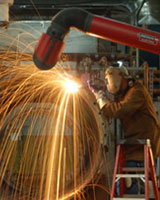Exhibit Fabrication Jobs
Exhibit fabrication jobs involve cutting, texturing, shaping, welding and coloring various metals. By using the most technologically advanced fabrication techniques, an artist does not have to limit their creativity. Metal sculpturing is a long-used art form. Although initial sculptures utilized masonry materials, metal was eventually added to this artistic specialty. Most exhibit fabrication jobs use metal more than any other type of material.
Stone Versus Metal Exhibit Fabrication Jobs
However, working with metal is much different that working with stone. With stone, the artist begins with a block of masonry and removes all pieces that are unnecessary for the finished sculpture. Once everything has been shaped and smoothed, the final product is created. But with metal, the artist does not start with a foundation of material. Instead, they must collect the metals they need. Then, they can shape and weld them in order to make the final form. Stone is notorious for being fragile and difficult to manipulate without breaking. However, metal is durable and depending on the end result, can suit a variety of purposes.
Exhibition fabrication jobs that call for molded metal work are completed a little bit differently. First, a mold must be made. Hot, liquid metal will be poured into the mold. Once the metal has cooled into a solid form, the piece can be removed. Metal pieces used for exhibit fabrication jobs can also be polished and painted. Sometimes, artists combined metal with other materials in order to fulfill exhibit fabrication jobs. Some common materials are plastic, rubber and wood, all of which add certain depth and character to a piece.
Flexible and Motorized Exhibit Fabrication Jobs
Although metal is a rigid material, skilled artists can make sculptures flexible according to exhibit fabrication jobs. When metals are joined in a particular way, they become static, allowing the entire piece to move and bend. Some exhibition fabrication jobs call for the creation of motorized metal sculptures. There are instances when gasoline or electric engines are utilized to force the moving parts of a metal sculpture to operate with timely precision.
Shapes and Sizes
One of the most unique aspects of exhibit fabrication jobs is the amount of creativity the metal worker can use. Sculptures can be created in a wide variety of sizes and there is no rule that states pieces must appear to be realistic. Some artist form mind-boggling creations from scrap metal in salvage yards, dumpsters and other unexpected locations. The artist is also not limited to the materials they can incorporate into an exhibit. As long as a metal can be either shaped, joined or cast, it can be used. And thanks to modern fabrication technology, almost any metal can be manipulated.
Practical Uses for Exhibit Fabrication Jobs
Although the majority of exhibit fabrication jobs involve art creation, metal sculpturing can be utilized for more practical reasons. For instance, a metal piece with a flat surface can serve as a table. Other pieces of metal that are tall and thin can be used for lamp stems. A squat, hollow piece makes for an ideal flower pot. The possibilities are endless.

